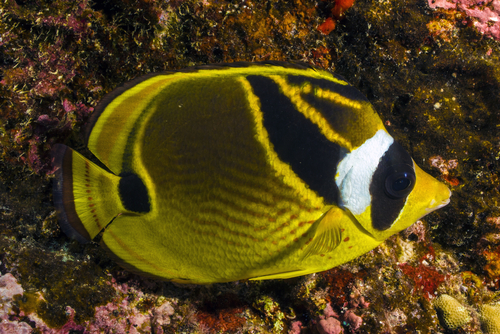There are endless types of fish in the world; more than 33000 and among these, there are many popular fish starting with R that could be a perfect match for your tank. So, have you ever stopped to think about how many different fish there are that start with the letter R?
Here’s 75+ popular fish starting with R:
- Raccoon butterfly fish (Chaetodon lunula)
- Ragfish (Icosteus aenigmatic)
- Razorback sucker (Xyrauchen texanus)
- Rattail (Disocactus flagelliformis)
- Ray (Batoidea)
- Rabbitfish (Siganidae)
- Rasbora (Rasbora)
- Rainbow trout (Oncorhynchus mykiss)
- Rainbowfish (Melanotaeniidae)
- Ratfish (Hydrolagus colliei)
There you have it! popular fish that start with R. Now that you know a little bit more about these fish, what are you waiting for? Get out there and start catches some R-named fish of your own!
Contents
75+ popular fish starting with R
Other similar posts:
Popular Fish That Start With S
Popular Fish That Start With P
Popular Fish That Start With N
1. Raccoon butterfly fish (Chaetodon lunula)
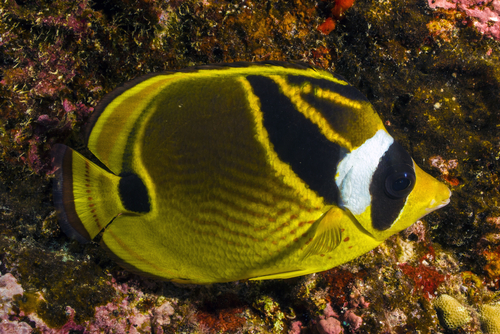
The raccoon butterflyfish is a beautiful creature that is native to the Indo-Pacific region. It is easily recognizable by its black and white stripes, which resemble a raccoon’s mask.
The raccoon butterflyfish is a popular choice for saltwater aquariums because of its striking appearance. However, there are a few things potential owners should know before adding one to their tank.
Size and Lifespan
Raccoon butterflyfish grow to be about 6 inches long and have a lifespan of 5-8 years. They are relatively peaceful fish but may become aggressive towards fish that are similar in size or appearance.
It is best to keep them with other peaceful fish that are not too small, as they may become nippy.
Diet and Feeding Habits
Raccoon butterflyfish are omnivores and primarily feed on zooplankton in the wild. In captivity, they should be fed a diet of frozen or live food, as well as some vegetable matter.
It is important to provide them with a varied diet so that they get all the nutrients they need. Overfeeding can lead to health problems, so it is best to err on the side of caution when feeding them.
2. Rabbitfish (Siganidae)
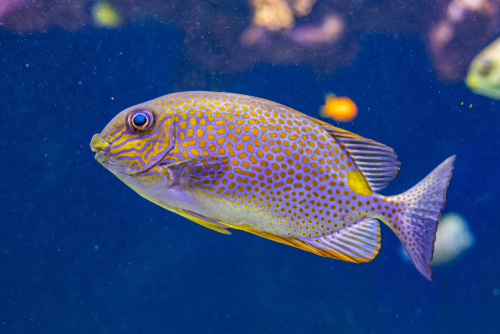
The rabbitfish is a type of marine fish that is found in tropical and subtropical waters around the world.
Rabbitfish are characterized by their long, rabbit-like snouts, which they use to root around in the sand for food. These curious creatures are gentle giants, and they make a great addition to any saltwater aquarium.
Rabbitfish are relatively large fish, and they can grow to be up to three feet long. They are usually gray or brown in color, with white spots all over their bodies. Rabbitfish are peaceful fish, and they get along well with other fish in an aquarium setting.
One of the most interesting things about rabbitfish is their diet. In the wild, rabbitfish eat a variety of different things, including algae, crustaceans, and small mollusks.
However, in an aquarium setting, it is best to feed them a diet of marine algae and seaweed.
Rabbitfish are not overly active fish, but they do enjoy swimming around and exploring their surroundings. They are relatively easy to care for, and they make a great addition to any saltwater aquarium.
If you are looking for a unique and interesting fish to add to your collection, then be sure to check out the rabbitfish!
3. Rasbora (Siganidae)
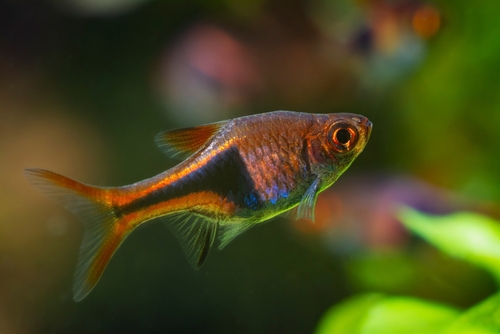
The Rasbora is a small freshwater fish that originates from Southeast Asia. There are many different
species of Rasbora, and they come in a variety of colors and patterns. The most common colors are black, silver, or gold, but there are also some red and green varieties. Rasbora typically grow to be about 2-3 inches in length.
Rasbora are peaceful fish that do well in community tanks. They prefer to live in groups of 6 or more fish of the same species. Rasbora are not territorial and will not fight with other fish species. However, they may be bullied by larger or more aggressive fish.
Therefore, it is important to choose tank mates carefully when keeping Rasbora. Rasbora are omnivorous and will eat both plant matter and small crustaceans or insects. In the wild, they typically feed on algae, small insects, and larvae.
In captivity, they can be fed a variety of foods including flakes, pellets, live foods, and frozen foods. It is important to provide a varied diet to ensure proper nutrition.
4. Rainbowfish (Melanotaeniidae)
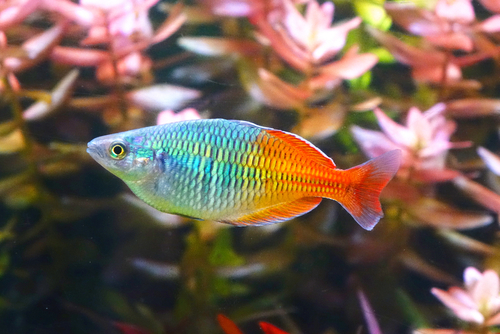
The rainbowfish is a brightly colored freshwater fish that is native to Australia and New Guinea. Rainbowfish are known for their vibrant colors and patterns, which can include blues, greens, oranges, reds, and yellows.
These fish are relatively small, typically only growing to be about four inches long.
Rainbowfish are popular aquarium fish because of their bright colors and easy-going nature.
They are peaceful fish that get along well with other species. Rainbowfish are also easy to care for, as they do not require a lot of special attention.
5. Ratfish (Hydrolagus colliei)
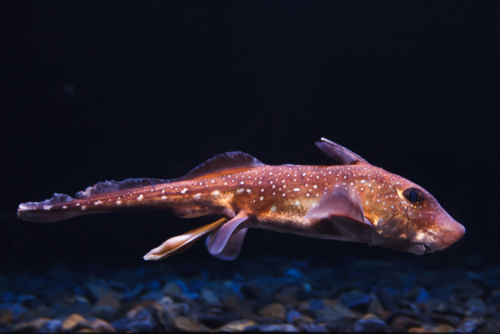
The ratfish is a type of fish that is found in deep waters all around the world. The ratfish gets its name from its long, rat-like tail.
This fish also has large eyes and a wide mouth, which can sometimes make it look like it’s smiling. Although the ratfish may not be the most attractive creature in the sea, it’s actually quite harmless.
The ratfish is a slow swimmer, but it makes up for this by being able to hover in place for long periods of time. This ability to stay still in the water helps the ratfish avoid predators.
When a predator does come along, the ratfish has another trick up its sleeve; it can release a cloud of ink into the water to confuse the predator and make its escape.
Despite their somewhat scary appearance, ratfish are actually quite gentle creatures. They are not known to attack humans or other animals. In fact, the only thing that ratfish eat are small invertebrates like shrimp and crabs.
So, if you’re ever lucky enough to spot a ratfish while you’re out swimming, don’t be afraid! Just enjoy observing this fascinating creature in its natural habitat
6. Ragfish (Icosteus aenigmatic)
Ragfish start their lives as eggs, which are incubated inside their mother’s body until they are ready to hatch. Once they hatch, they are on their own. They must fend for themselves immediately, as their mother does not stick around to care for them.
This is actually quite common among fish; most species abandon their young as soon as they are born. But what sets ragfish apart is their determination and resilience.
No matter how difficult their start in life may be, ragfish never give up. They will fight tooth and nail to survive, even if the odds are against them.
This tenacity serves them well throughout their lives. Ragfish live in some of the harshest environments on Earth, including the deep sea where light does not penetrate and temperatures are near freezing. Yet somehow, they manage to thrive in these conditions.
Ragfish are also known for their endurance. They have been known to swim non-stop for days at a time, covering vast distances in search of food or mates.
And when they finally do stop to rest, it’s not for long; they’ll be back on the move again before you know it.
7. Razorback sucker (Xyrauchen texanus)
The Razorback sucker (Xyrauchen texanus) is a large fish that can grow up to four feet in length. It is a freshwater fish that is native to the southwestern United States.
The razorback sucker was once a common species, but it has declined sharply in recent years and is now considered to be endangered.
Habitat and Distribution
The razorback sucker is found in lakes, reservoirs, and slow-moving rivers. It prefers habitats with sandy or muddy bottoms.
The fish is native to the southwestern United States, but it has been extirpated from much of its former range.
Today, the species is only found in a few states, including Arizona, Colorado, Nevada, New Mexico, Utah, and Wyoming.
Life History and Behavior
The razorback sucker is a long-lived fish; individuals have been known to live for more than 20 years. The fish spawns in the springtime. Females lay their eggs in nests that are constructed by males.
After hatching, the young razorback suckers remain in the nest for several weeks before moving out on their own.
The razorback sucker is mostly a herbivore, feeding on algae and aquatic plants. However, the fish will also consume small invertebrates if they are available.
8. Rattail (Disocactus flagelliformis)
The Rattail fish is a long, thin fish that is found in deep water. It has a long, thin tail that is similar to a rat’s tail, hence its name. The Rattail fish is a popular food fish and is often used in sushi. It is also a popular bait fish.
The Rattail fish is found in deep water all over the world. It is a popular food fish and is often used in sushi. It is also a popular bait fish.
The Rattail fish has a long, thin body and a long, thin tail that is similar to a rat’s tail, hence its name. The Rattail fish is a bottom-dweller and feeds on small invertebrates.
The Rattail fish is an important commercial species and is fished all over the world. In Japan, the Rattail fish is considered a delicacy and is often used in sushi.
In other parts of the world, it is mostly used as bait for larger predators such as sharks and tuna.
9. Ray (Batoidea)

The ray fish is a type of fish that is closely related to the shark. It is found in all oceans of the world and can grow up to 6 feet long! The ray fish has a flat body and often has a sting on its tail. Keep reading to learn more interesting facts about the ray fish!
The ray fish is a predators, preying on smaller fish, squid, and crustaceans. They use their stingers to paralyze their prey before eating them whole. The stingers are also used for defense against predators such as sharks.
Ray fishes are ovoviviparous, meaning that they keep their eggs inside their bodies until they are ready to hatch. The baby rays are called pups. Once they are born, they are on their own and must fend for themselves.
10. Rainbow trout (Oncorhynchus mykiss)
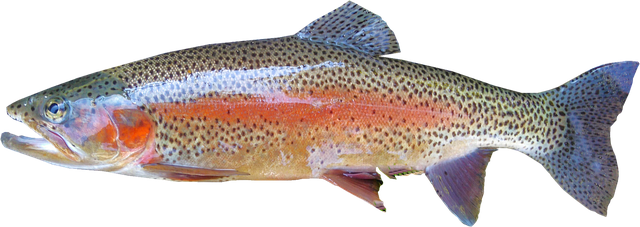
The rainbow trout is a species of fish that is native to cold-water tributaries of the Pacific Ocean in Asia and North America.
The name “rainbow trout” is derived from the typical bright-red stripe running down the center of the fish’s body.
Rainbow trout are popular among anglers and are also commonly raised in hatcheries for stocking purposes.
Where do Rainbow Trout Live?
Rainbow trout are found in cold-water tributaries of the Pacific Ocean in Asia and North America. In the United States, they are most commonly found west of the Rocky Mountains. In Asia, they are found in Russia, Korea, and Japan.
What Do Rainbow Trout Eat?
Rainbow trout typically eat smaller fish, insects, and crustaceans. The diet of a rainbow trout can vary depending on their location and what food is readily available.
Saltwater fish starting with R:
1. Rice eel (Monopterus albus)
2. Rio Grande perch (Herichthys cyanoguttatus)
3. Reedfish (Erpetoichthys calabaricus)
4. Rockweed gunnel (Apodichthys fucorum)
5. Righteye flounder (Pleuronectidae)
6. Redfish (Sciaenops ocellatus)
7. Riffle dace (Rhinichthys)
8. Rockling (Gaidropsarus mediterraneus)
9. Redlip blenny (Ophioblennius atlanticus)
10. Roach (rutilus roach)
11. Roughy (Hoplostethus atlanticus)
12. Russian sturgeon (Acipenser gueldenstaedtii)
13. Redtooth triggerfish (Odonus niger)
Freshwater fish that start with R
1. Rudderfish (Centrolophus)
2. Razorfish (Aeoliscus strigatus)
3. Ridgehead (Melamphaidae)
4. Red velvetfish (Gnathanacanthus goetzeei)
5. Ropefish (Erpetoichthys calabaricus)
6. Red salmon (Oncorhynchus nerka)
7. Red snapper (Lutjanus campechanus)
8. Rock beauty (Holacanthus tricolor)
Tropical fish that start with R
1. Ribbonfish (Trachipteridae)
2. Redhorse sucker (Catostomidae)
3. River shark (Glyphis)
4. Red grouper (Epinephelus morio)
5. Ribbon sawtail fish (Idiacanthus fasciola)
6. Round herring (Spratelloides gracilis)
7. River stingray (Potamotrygon motoro)
8. River loach (Balitoridae)
9. Roosterfish (Nematistius pectoralis)
10. Roanoke bass (Ambloplites cavifrons)
11. Roundhead (Stropharia caerulea)
12. Rock cod (Lotella rhacina)
13. Rock bass (Ambloplites rupestris)
14. Round stingray (Urolophus halleri)
15. Remora (Echeneidae)
16. Rough sculpin (Cottus asperrimus)
17. Ronquil (Bathymasteridae)
18. Ricefish (Oryzias latipes)
19. Requiem shark (Carcharhinidae)
20. Ribbon eel (Rhinomuraena quaesita)
21. Rohu (Labeo rohita)
22. Rockfish (Sebastes)
23. Ruffe (Gymnocephalus cernua)
24. Redmouth whalefish (Rondeletia)
25. Rough scad (Trachurus lathami)
26. Round whitefish (Prosopium cylindraceum)
27. Redfin perch (Perca fluviatilis)
28. Reef triggerfish (Rhinecanthus rectangulus)
29. Rudd (Scardinius erythrophthalmus)
30. Rivuline (Rivulus)
31. Red whalefish (Rondeletia loricata)
32. Rocket danio (Danio feegradei)

Ian Sterling, founder of Fishlab.com, began his aquarium journey over 30 years ago, driven by a deep fascination for fish and their diverse personalities. His website, Fishlab.com, is dedicated to making fishkeeping accessible and enjoyable, offering beginner-friendly guidance, expert insights, and a community for aquarists to connect and share experiences.


